THE WHOLE TRUTH ABOUT FATIMA VOLUME II
THE SECRET AND THE CHURCH
2.5. “Poor Russia”: From Christendom
to the Hell of the Gulag (1917 - 1931).
WHILE at Fatima, from May 13 to October 13, the Queen of the Most Holy Rosary appeared to Her three shepherds and set up the throne of Her Mercy at the Cova da Iria, to make Portugal during forty years the most blessed country under Heaven – at the same moment at the other end of Europe, Russia wallowed in the Bolshevik revolution, the most horrible revolution ever seen, and also the most dangerous and frightful one for all Christendom.
RUSSIA IN THE MYSTERY OF FATIMA
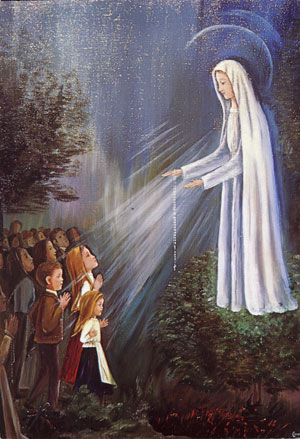
1917: only one date for these two events, undoubtedly the most important and decisive ones of our century. The coincidence is especially remarkable because Our Lady of Fatima, on July 13, looking very sad and afflicted, spoke with the three children about the fate of this poor Russia, on whose fate also depended the fate of the rest of the world.
The coincidence of the dates is so visibly providential that since then all historians have commented on it, but it is important to grasp its real significance. Must we, with several authors,1 present the events of Fatima side by side with those of Moscow in parallel portraits, giving between the account of each apparition the corresponding episode of the Bolshevik revolution? No. For the message concerning Russia is part of the great Secret, which Our Lady asked the children to reveal to no one. And, in fact, Lucy did not say a word about Russia until 1929. Thus the chronological parallel linking month by month the events in Moscow and Fatima during 1917 is practically insignificant, and usually arbitrary. On the contrary, this long silence of Heaven – a silence which was willed and deliberate, since the Blessed Virgin spoke of it, but did not want Her words revealed until a dozen years later, in the bloodiest years of Stalin’s persecutions – we must now explain, drawing from it the most salutary lessons.
In short, it is useless to seek in the Secret of Fatima the key to various episodes which culminated in the “October Revolution”. But on the other hand, it is rather the history of Soviet tyranny from 1917 to 1929 which allows us to understand the true meaning of both the great Secret, which ought to have been revealed sometime between 1927 and 1930, and the great revelation of Tuy in 1929. We must have in our minds this first decade of the Soviet Gulag to discover the immense and infinite wisdom of the great plan of God revealed at Tuy... and to understand how easy it was, at that time, for the Pastors of the Church to accomplish, as good children of Our Lady, Her little requests.
Yes, it would have been easy to obey and to consecrate Russia to the Immaculate Heart of Mary, but only on the condition of making the same judgment as Heaven concerning “poor Russia”, its thousands of martyrs, its millions of victims, and their persecutors, the cold-blooded butchers, the Lenins, Trotskys and Stalins, all of whom had blood on their hands.
This preliminary condition remains today: we can understand nothing either of the drama of our century, or the response brought to it by Our Lady of Fatima, so long as we do not recognise the true nature of communism. Only an authentic history, stripped of all “whitewashing” and fallacious ideological pretexts lets us discover, to our horror, that since 1917 Bolshevik Russia is a veritable Hell; yes, literally. Are all its atrocities known to us? Perhaps. Are we aware that Bolshevism created sixty million victims in Russia? Yes, but that is said too quickly. Because we do not “realise” everything that this represents in hatred and Satanic complicity, as well as atrocious suffering, we do not learn from all the consequences which follow from it, and we do not understand the means chosen by Heaven to save this «poor Russia», as Our Lord would later say while speaking to Sister Lucy, in a tone of immense compassion.
I. FROM “HOLY RUSSIA” TO THE REVOLUTION: A TOTAL RUPTURE
Indeed one of the first important truths which must be solidly established, under pain of dangerously deceiving ourselves concerning Russia and communism, and consequently the words of Our Lady of Fatima as well, is that the Bolshevik revolution is not Russian. It is fundamentally, essentially anti-Russian, as Solzhenitsyn has never tired of demonstrating to the West, which has voluntarily blinded itself on this point. 2 Already in 1976, against all those who tended to present the Soviet Gulag as the authentic heir of Czarist Russia, the Abbé de Nantes insisted forcefully:
«The Bolshevik phenomenon developed like a cancer on the body of “Holy Russia”. It remains totally foreign to it. Neither the orthodox religion nor Slavic tradition have the least affinity with its inhuman dialectic. And if communism took possession of this country, it is not in virtue of an illusory “historical dialectic”, but quite simply because this great body with a sick head was easier to take and, undoubtedly, had no other agitating minority beside the Jewish Bolshevik clan. Not only is the Soviet power the enemy of the human race, it is before all else the enemy of the Russian people and the other enslaved peoples.» 3

But did not the Czars, by their oriental tyranny, at least open the way for Bolshevism? This has been stated and repeated many times; but wrongly:
«Everything in our history books is written to give us the impression that they provoked the dissatisfaction of their people by their autocratic ways, by their harshness, their lack of ability, their religious fanaticism, their social injustice, their immobilism in economic matters, until finally the general revolution drove them out. Nothing is more false...
«During this dramatic nineteenth century, the Czars of Russia lived as good and honest princes, concerned with the good of their peoples. They all assumed their mission as representatives of God over the land of Russia, and defenders of the orthodox peoples.» 4
Their only error, their sole fault faced with the menacing revolution, which moreover was foreign in inspiration, was their excess of liberalism, their lack of foresight and firmness in extirpating the evil before it was too late. As for Nicholas II, at the beginning of this twentieth century, he was surely the most humane head of State, the most loyal to his allies, the one most concerned for the good of his people, and the most profoundly Christian as well. Between him and Lenin there is as radical a break as between Louis XVI and Robespierre.
Thus the evil did not come fundamentally from Russia or its Czarist regime, it came from elsewhere... Bolshevism is the revolution in its very essence, pushed to its most logical term in an implacable manner. This is what created the force and particularly frightful character of that “October Revolution”. This is the revolution whose irreversible success and universal triumph Lenin – inspired by what spirit we can guess – prophesied.
THE INFERNAL MACHINE
The events are well known. We will recall only those which will be useful in the development of our exposition. The insurrection broke out at Petrograd in February, 1917. On March 15, Nicholas II felt obliged to abdicate. The insurgents then formed a provisional government presided over by Prince Lvov, who soon committed the infamous crime of arresting the royal family. In April, Lenin, who had taken refuge in Switzerland, returned to Russia in a railroad car sealed with lead, under the protection of the German government, Thanks to the gold of Kaiser William II and the financial help of the Jewish bankers in New York, Bolshevik propaganda intensified. At that time, the Party had seventeen daily papers at its disposal, with a total circulation of 320,000 copies. 5
In July, there was a new revolutionary insurrection. Lenin however hesitated, and the attempt to seize power failed. Yet the decision was made: the armed insurrection would take place «when circumstances dictate it to us, but by autumn at the latest». 6 Prince Lvov resigned and the freemason and democrat Kerensky replaced him in the provisional government. In September, after some new military defeats, General Kornilov wanted to seize power, but Kerensky dismissed him. Kornilov then sent his troops marching on St. Petersburg. Then Kerensky, pushing stupidity and treason to the extreme, called the Soviet to his aid! Thus the Bolsheviks took leadership of the resistance to Komilov’s army. Kornilov then saw the majority of his troops abandon him, to go over to the side of the revolutionaries. Kerensky was able to proclaim the republic on September 14, but he was now without authority. After the Soviet of St. Petersburg rallied over to the Bolsheviks (on September 13) and that of Moscow imitated it shortly after, the days of Kerensky’s government were numbered. 7
On October 25, the revolution triumphed and the Bolsheviks occupied the winter palace. The infernal machine functioned flawlessly and in record time: the legitimate national monarchy, paternalistic and of divine right, was overthrown in the name of liberty and democracy, with the subsidies of the German enemy and the complicitous apathy of the allies. Eight months later, the incapable and impotent liberal republic had to give way to the Bolshevik dictatorship.
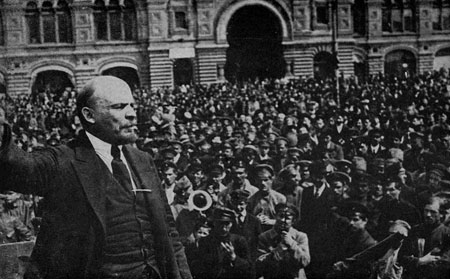
II. LENIN: THE TERROR IS INSTALLED (1917-1924)
After a few weeks of debauchery, at the end of 1917, misery began to be felt, with disorganised transport, unemployment and civil war taking the place of foreign war.
THE PERSECUTIONS BEGIN...
On January 20, 1918, a decree «proclaims the separation of Church and State, confiscation of the goods of the Church and the suppression of its legal rights». 8 In fact the persecutions, which had begun in October, continued afterwards more or less virulently whenever the Bolsheviks had the opportunity.
Religious persecution! Yes, first and above all, because religion is the most hated, detested enemy. But Bolshevik hatred extends well beyond that: communism in its origin and roots is «a ferocious atheism», as Solzhenitsyn writes. But «it is accompanied with a permanent unlimited fury against everything which is not itself, which existed before it and tries to survive beside it, without it, in spite of it. It is the “jacobin terror” radicalised, universalised, eternalised.» 9
THE MARTYRDOM OF THE IMPERIAL FAMILY
«The unfading honour of the last of the Romanovs was to have perished in this torment, the Czar, the Czarevich and the Czarevnas, for their fidelity to their God, their nation and their allies...
«As prisoner of the Bolsheviks, or more precisely a handful of Jewish revolutionaries, the imperial family manifested the greatest nobility of sentiments, the most lively Orthodox piety, the most profound attachment to the Russian people and even the Czarina Alexandra who had refused exile, declared herself inviolably attached to the soil of her native country. They were all massacred with the last of their servants during the night of July 16-17, 1918, at Ekaterinburg, by a group of supposed German prisoners, in reality Jewish assassins sent by Moscow. You will not find any of these details in your Heller and Nekrich in spite of its 658 pages (cf. p. 55). Of course! But we learned them from a Swiss gentleman, a witness of the intimate life and final days of Czar Nicholas Romanov and his family. 10 It is edifying. We have good reason to conclude that they were killed by diabolical men, out of hatred for the Christian faith and the Russian nation.» 11
« THE WAY OF TERROR»
The liberty which had been announced immediately turned into organised, systematic terror: Lenin declared at the time that « the way of terror is the only one open to us and we cannot avoid it. Do you imagine that without the brutal, uninhibited revolutionary terror, it would be possible for us to prevail?» 12
In October, 1917, the peasants had been granted the lands of the rich proprietors. Now however, all the harvests from these lands were being requisitioned, and everywhere the peasants attempted to revolt. On August 9, Lenin decided « to put into effect a pitiless mass terror». At that moment concentration camps were created, where adversaries of the regime whom the secret police had not yet shot down perished by the tens of thousands. People of influence, peasants, soldiers, anyone who seemed capable of putting up any opposition to Bolshevism was eliminated without pity. 13
In November 1919, Patriarch Tikhon of Moscow addressed a pathetic appeal to Europe: «Bishops, priests, monks and nuns are shot down en masse under the vague pretext of “counter-revolution”. Through a refinement of cruelty the supreme consolation of the sacraments is refused them, while their relatives cannot obtain a Christian burial for their bodies.» 14
In 1922, Cardinal Mercier published the first figures:
«Statistics for the victims of the persecution are frightening. Since November 1917, 260,000 simple soldier prisoners and 54,000 officers; 18,000 landed proprietors; 35,500 “intellectuals”; 192,000 workers; 815,000 peasants; 28 bishops and 1,215 priests were put to death.
«To these last figures we must add an as yet unknown number of priests both orthodox and Catholic who were condemned and executed these last months for refusing to cooperate with the decree ordering the confiscation of sacred objects.» 15
In fact, a decree of February 26, 1922, confiscated all the treasures of the Church, including consecrated objects. The faithful attempted to oppose it.
In three months, «1,414 bloody incidents were recorded, brushes between the faithful and the troops». Lenin took advantage of this to give his instructions to all members of the Politburo: «This is precisely the best time to give a lesson to this whole breed so that for several years, they do not even think any more of any sort of resistance.»
«We must arrest as many as possible of the “representatives of the reactionary bourgeoisie and the reactionary clergy”, have a show trial, and shoot down “a very great number”... In all 8,100 priests, monks and nuns were shot in 1922.» 16
This frightful slaughter was the effect of cold calculation, an implacable and lucid decision: in May 1922, when he became aware of the first projects of the Soviet penal code, Lenin insisted without pity: « Jurisprudence must not put an end to the terror; to promise that would be tantamount to blinding ourselves or deceiving others; it must provide a foundation for it and legalise it in principle, without any falsehood.» 17
ANOTHER MEANS OF EXTERMINATION: FAMINE
During this time, for almost two years the population had been decimated by a terrible famine for which drought had not been the only cause. The revolution had seriously disorganised all agrarian life: innumerable peasants had been deported or massacred. The forced requisition of all harvests in 1918, 1919 and 1920 had discouraged them from continuing to sow, and work purely for the profit of the Red Army and the members of the Party. The factories and transports no longer functioned except sporadically.
In 1921, the misery became frightful: no more food, no more clothing, no more fuel. At St. Petersburg, wooden houses were being burned by the thousands with no end in sight. In the hospitals there was no longer any medicine, or nurses or doctors. Father d’Herbigny wrote in 1923:
«A witness of recent events affirmed however that they continued to dump innumerable dying people: the families got rid of them to escape contagion, or simply to avoid seeing their horrible agonies. All categories of the sick are gathered in the same rooms. In their midst are long chests, always open, which receive the cadavers to the extent that deaths continue: they are filled, gorged, stuffed with them. Each day a team passes by to load them onto trucks; another comes by a few hours later bringing back the chests – the same chests, not disinfected – to receive a new load.
«There are no more funerals or even burials. It would take too long to bury all these bodies. The rivers carry many of them away. It is said that they are even used, “temporarily, as long as the famine demands”, to fatten the pork.» With the permission of the Moscow government. 18
«At the end of the Civil War, and as its natural consequence, an unprecedented famine developed in the Volga area... to the point of cannibalism.» 19
And now a horrible fact which defies all imagination: this famine, which in 1922 had already created ten million victims, was an integral part of the Bolshevik plan. In September 1918, Zinoviev, the intimate friend of Lenin who had returned to Russia with him in the famous sealed boxcar, declared and wrote: «We will prevail; of the Russian people, 90 million are under the power of the Soviets. The rest? We will exterminate them.» 20 It must be understood that the empire of the Czars numbered almost 180 million souls. The war and the cruelty of the State had reduced the population to about 130 million. Well, there were still about 40 million Russians too many! In 1918, one could read the following words in the official organ of the Soviet of Petrograd:
«We will render our hearts cruel, harsh, without pity. We will open the dams of this bloody sea. Without pity, without mercy, we will kill our enemies by the thousands. We will drown them in their own blood.» 21
But hunger executes more quickly than the machine gun. It makes less noise and requires less procedure. Heller and Nekrich rapidly pass over such horrors. We must read the overwhelming account in the work of Father d’Herbigny, who was then in constant communication with numerous witnesses.
It was indeed a case of a frightful genocide and a martyred people:
«A moving example was given by many of the dying. When they sensed that they were about to fall, these Christians prayed one last time before the dear family icons which guarded the household. Then, either alone or held up by their dear ones, at times entire groups of the dying would go to the cemetery, towards their families’ sepulchre. Nobody could bury them there. But having breathed their last gasp on consecrated ground, they would not be thrown off it. After an effort which often took them two or three hours, they would cover a few hundred yards. They arrived, they prayed for their deaths and then, lying down on their sepulchres, they would extend their arms in the form of a Cross, and wait. Hundreds, even thousands, died in this position.» 22
III. STALIN: THE TERROR CONTINUES
The years following the death of Lenin, in 1924, saw the irresistible rise of Stalin, who successfully eliminated all his rivals. In 1929, he finally achieved total control of the Soviet Empire. Deliberately, satanically, he launched the infernal machine once more: purges, persecutions, famines.
THE LIVING HELL OF THE YEARS 1929-1933
«In April of 1929, the sixteenth Party Conference decided on a second general purge (the first had taken place in 1921).» Thousands of functionaries were thus sanctioned, eliminated.
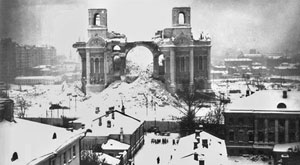 THE PERSECUTIONS. During this time, the impious propaganda designed to kill the faith of the masses intensified. In 1925 “the Union of Militant Godless” was created. Its journal, the Bezbojnik (meaning the “Godless”) organised conferences and blasphemous demonstrations. The association distributed films, created museums to spread atheism especially among the youth, and to make the struggle against religion more effective.
THE PERSECUTIONS. During this time, the impious propaganda designed to kill the faith of the masses intensified. In 1925 “the Union of Militant Godless” was created. Its journal, the Bezbojnik (meaning the “Godless”) organised conferences and blasphemous demonstrations. The association distributed films, created museums to spread atheism especially among the youth, and to make the struggle against religion more effective.
A law of April 9, 1929, gave a new pretext for another outbreak of the persecution: «Hundreds of churches were demolished, including historical monuments...» On August 27, the “continuous week” was introduced, which suppressed the Sunday. During the years that followed, the secret police (the KGB of that time, which had replaced the Cheka) achieved the extermination of the Catholic clergy of Ukraine.
THE DEKULAKISATION. On November 7, 1929, Stalin published an article with far-reaching implications: « The Year of the Great Rupture.» It dealt with passing «through a new revolution» to collective agriculture. But the revolution is first of all terror: «After the policy which consisted in limiting the exploitive tendencies of the Kulaks (sic), we pass on to a new policy of liquidation of the Kulaks as a class.» This was the creation of the collective farms and “dekulakisation”.
Massacred, deported, starved, once again it was by the millions that the peasants perished in atrocious sufferings:
«The kulaks and kulakisers were deported with their families. By the hundreds of thousands they were led away in unheated box cars thousands of miles away, to the faraway regions of the Urals, Siberia or Kazakhstan. Many died on the way or on arrival, for as a general rule, the deported were left in deserted places: forests, mountains, steppes.
«The ruin of the countryside by the interminable dekulakisation and deportation led, in 1932-1933, to a famine which, in its extent and the number of its victims, was even worse than that of 1921-1922. Not only did the State not struggle against it, but it even contributed to amplifying it, utilising it as a weapon in its “civil war” against the peasants.» For during this time the government continued to export wheat!
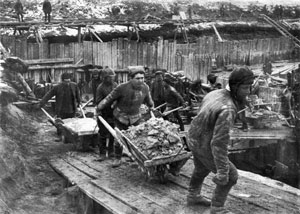 The number of victims? That is difficult to know. What is certain is that the secret police informed Stalin of the suppression of three and a half million kulaks. Stalin himself was bold enough to tell Churchill that during the collectivisation, “justice was done” to «ten million kulaks, of whom the great majority were annihilated, and the others sent to Siberia». But the most serious demographers count at least fifteen million victims of this nightmare of the years 1929-1933. 23
The number of victims? That is difficult to know. What is certain is that the secret police informed Stalin of the suppression of three and a half million kulaks. Stalin himself was bold enough to tell Churchill that during the collectivisation, “justice was done” to «ten million kulaks, of whom the great majority were annihilated, and the others sent to Siberia». But the most serious demographers count at least fifteen million victims of this nightmare of the years 1929-1933. 23
As for those whose lives were spared, they were reduced by the thousands to an inhuman slavery: the gulag took on gigantic dimensions; tens of millions of slave labourers became the indefinitely renewable raw material for the extreme industrialisation decreed by the five-year plan of 1928.
Here are the facts, here is the reality perfectly well known to us through innumerable witnesses, from Kravchenko 24 to Solzhenitsyn, among so many others who have all described this atrocious drama of the “Gulag Archipelago”.
IV. THE COMMUNIST REVOLUTION: A WORK OF SATAN
BOLSHEVISM UNMASKED

Here, in all clarity, are the lessons to be learned from the undeniable exposition of the facts:
«It is better to recall this history than to give an abstract dissertation on Marxism-Leninism... The dictatorship of Lenin and Stalin, like that of Bela Kun, is founded on absolute hatred of law, on terror, secret denunciation and death camps. For this reason it escapes the yardstick of all traditional ethical standards. But even more, this totalitarian dictatorship of the State or of the Party (it is the same thing) has no constructive project except for the alleged liberation of the proletariat, which is a snare. Its only function is to destroy society in its religious and human foundations, to constrain it continually under terror to make it the simple instrument of its universal hatred and its expansion in the world.
«Once the State is conquered, the Party no longer has any other purpose, neither service nor justice, except its own domination in the annihilation of all rival reality or power, whether spiritual, intellectual or even economic. These are denounced as reactionary. The dictatorship is implacable, as absolute as a religion... And it must be observed, with the most perceptive and courageous historians: it is a Jewish, xenophobic dictatorship, transposing racist biblical messianism into the messianism of the Party, oppressor of the peoples. The Bolshevik dictatorship is in the service of a religious faith which is neither human nor Christian, and therefore can only be Satanic.» 25
This is indeed the only possible explanation. History compels us to this conclusion even more than an analysis of the confused and mendacious texts of Marx or Lenin. The Bolshevik revolution can only reach such depths of inhumanity, always and everywhere, because it is «intrinsically perverse» and fundamentally Satanic. It is truly the work of “the Enemy of the human race”, who was “a liar and a murderer from the beginning” (John 8:44). The tree is known by its fruits: had anyone ever seen such a false utopia and homicidal fury raised to a system and an absolute law? Heller and Nekrich observed this fact, and it is especially valuable for us to see it coming from their pen: «The Great Terror is always preceded and accompanied by the Great Lie.» 26 These words say it all.
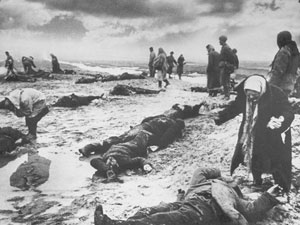
We are reminded of the “mystery of iniquity” spoken of by Saint Paul, which hitherto had been operating in secret and is suddenly revealed in broad daylight, concealing a Satanic hatred against God, against Christ, against the Church and against Christendom (II Thess. 2:3-12). Thus we have seen, since 1917, a veritable apocalyptic drama, a drama unprecedented in the entire history of humanity. Never had the forces of evil been unleashed with such power, and found nothing capable of opposing them.
For the other side to the drama, and the most stupefying fact of the century, is that the entire West (and to a great extent the Church itself, as we shall see) obstinately refused to admit these two facts staring them in the face: communism today is the instrument of Satanic domination, and if it meets with no obstacles it will soon threaten to spread to the entire planet. For even though Bolshevik Russia became a frightful “showcase of Hell”, the West’s blindness is so great that Lenin’s forecasts are being fulfilled to the letter: communism seduces all the nations before reducing them implacably to servitude:
«The example of the Russian Soviet Socialist Republic will be a living model for the peoples of all nations, and this model’s propaganda power and revolutionary impulse will be prodigious.» «... There is no force in the world which can oppose the Bolsheviks if they do not let themselves be intimidated, if they know how to seize power and retain it until the victory of the world socialist revolution.» 27
Endnotes
(1) Cf. Father Giuseppe M. Schweigl, S.J., Fatima e la conversione della Russia, p. 15 sq. Pontificio Collegio Russico, Rome, 1956. And above all, G. Cerbelaud Salagnac, Fatima et notre temps, France-Empire, 1967.
(2) Cf. L’erreur de l’Occident, Livre de Poche, 1980.
(3) “L’Église face aux dictatures. La dictature bolshevique”, CRC 105, May 1976, p. 6.
(4) Abbé Georges de Nantes, CRC 184, Dec. 1982, p. 21. Cf. Msgr. jean Rupp, Héros chrétiens de l’Est, hommage au déporté Kolbe, p. 137 sq., Lethielleux, 1972.
(5) Michel Heller and Aleksandr Nekrich, L’utopie au pouvoir. Histoire de l’URSS de 1917 à nos jours, p. 27. Calmann-Lévy, 1982.
(6) Ibid., p. 26.
(7) Henry Coston, Ces millions de morts dont on ne parle plus, Lectures françaises, April 1980.
(8) Heller and Nekrich, p. 113.
(9) CRC 184, p. 5.
(10) Gilliard, Le tragique destin de Nicolas II et de sa famille, Treize années à la cour de Russie, Payot, 1922.
(11) CRC 184, p. 22.
(12) Jean Ousset, Le Marxisme-Léninisme, p. 344. La Cité Catholique, 1960.
(13) Cf. Heller and Nekrich, p. 55-56.
(14) Quoted by Coston, Lectures françaises, p. 5.
(15) Quoted by Father Michel d’Herbigny, S.J., La tyrannie soviétique et le malheur russe, p. 237, Spes, 1923. Cf. Jean Ousset, Le Marxisme-Léninisme, p. 345.
(16) Heller and Nekrich, p. 114.
(17) Ibid., p. 117.
(18) La tyrannie soviétique, p. 50-51.
(19) Ulysses Floridi, S.J., Moscow and the Vatican, p. 16, Ardis 1986.
(20) Quoted by Coston, p. 5.
(21) La Gazette, September 1918, quoted by Coston, ibid.
(22) D’Herbigny, p. 99-100.
(23) Here our exposition is based solely on the facts furnished by Heller and Nekrich, who cannot be suspected of embellishing the facts or exaggerating the figures. The preceding quotations are taken entirely from this work, p. 183-201.
(24) V.A. Kravchenko, J’ai choisi la liberté. La vie publique et privée d’un haut fonctionnaire soviétique, éd. Self, 640 pages, 1947.
(25) Abbé G. de Nantes, “The bolshevik dictatorship”, CRC 105, May 1976, p. 5.
(26) P. 197.
(27) Lenin, Sur la grande révolution socialiste d’Octobre, 1917-1977, p. 15 and 34, Novosti, Moscow, 1977.